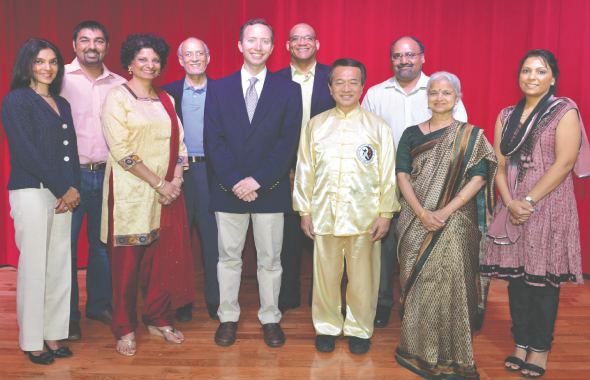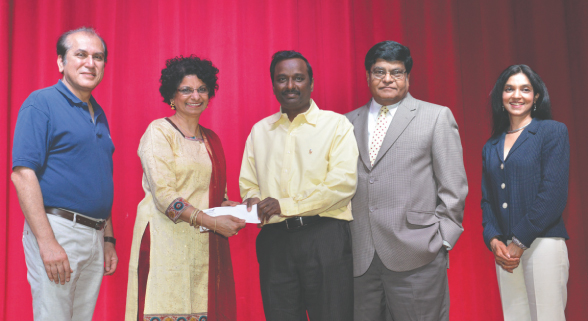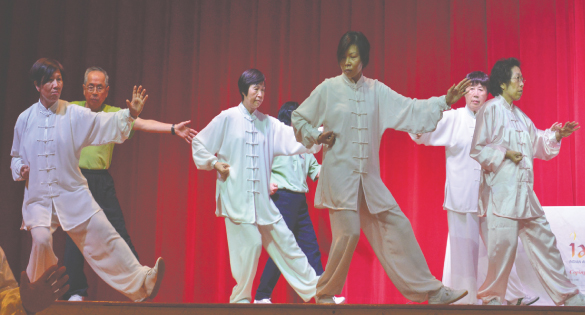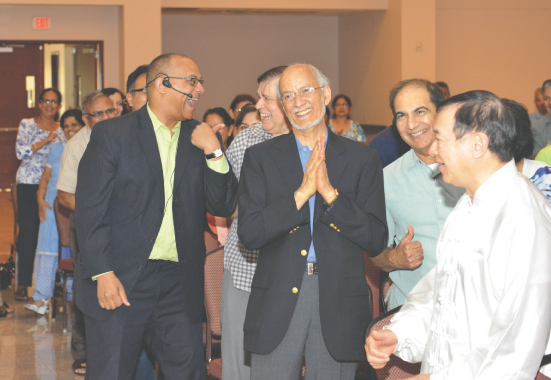IACAN: For Those Who Suffer, Relief Comes in Unexpected Ways
By Jawahar Malhotra
HOUSTON: The audience was on its feet. They were smiling and grinning. They were, in fact, bent over laughing, some so hard that tears were streaming down their cheeks. They embraced each other, wagged their fingers at one another, made eye contact, shook hands, did high-fives and made awkward gestures that erupted in laughter. And it was all because of that tall, loud, bespectacled man with a wireless headphone microphone who was going around the floor, between the seats egging them on.
The man was demonstrating the therapeutic power of laughter over the ill effects caused by pain and discomfort. “Too many people give out fake, polite laughter,” explained Chaplain Stephen Findley who works at M.D. Anderson Cancer Center at the Texas Medical Center, as he mimicked one, “but good, gut busting laughter involves yogic breathing down to the diaphragm and expelling it.” Findley is certified as a Laughter Yoga teacher, the Founder and Director of Shaka Seminars and a much sought after speaker.
Findley listed out some basic rules for Laughter Yoga to be effective: that it be unconditional, hearty, extended for up to 15 minutes, allowing the brain to secrete endorphins and be enthusiastic. He gave the example of how kids laugh “at nothing. Every part of their body laughs – their elbow, belly, even the back of their head” and jumped down from the stage to mingle with the audience and demonstrate, using one or two as a sidekick. He had them in stitches in no time, just using gestures and making provoking grunts, bellows and stares.
Even the organizers of the event, the Indo American Cancer Awareness Network, were cracking up in the side aisles, and the other three members of the “Living the Anti Cancer Life – The Mind-Body Connection” panel onstage were giggling too. The seminar was part of an ongoing effort by IACAN to educate the public on the dreaded disease and how to handle its effects, both physical and emotional, and pay for care.
The seminar was co-sponsored by the Susan G. Komen Foundation, the Indo-American Charity Foundation, and Vallabh Priti Sewa Samaj and held at the VPSS auditorium on Bellfort at the Southwest Freeway this past Sunday afternoon, April 28. IACAN Board member Lakshmi Naik gave a brief introduction on the program and the panelists who covered four areas of alternative and complimentary therapies that work well with conventional treatments. The IACF President Murthy Divakaruni and Board Directors Ramesh Cherivirala and this reporter presented a check of support to IACAN’s President Kanchan Kabad onstage.
The panel discussion started with Dr. Gabriel Lopez, an Assistant Professor in the Department of General Oncology, Section of Integrative Medicine at M.D. Anderson Cancer Center, who focuses on conducting integrative oncology consultations. “There is an abundance of information available about alternative and complementary medicine as well as many books discussing anticancer and finding a new approach to life,” Lopez said, “But be careful because much of it is not evidence based and may even be harmful to follow.”
He explained how alternative medicine encompassed a wide range of health care practices, products, and therapies not typically used in Western medicine like acupuncture, Ayurveda, Chiropractic, and Homeopathy. Complementary Alternative Medicine merges this with conventional medicine to complement the treatment through diverse medical and health care system, practices, and products not presently considered to be part of conventional medicine, such as probiotics, Tai Chi, mind body medicine-yoga and others. For example, he explained how music therapy helped children having a biopsy to ease their pain.
Coming after Findley was a discussion on the ancient Chinese science of acupuncture and acupressure by Sonya Patel, who owns and operates Mirvana Acupuncture and Chinese Herbs. Petite and young, Patel has spent several years in China honing her skills and explained how acupuncture and acupressure works on the 12 primary meridians of energy or chi passing through the human body. Although not a cure for ailments, acupuncture can relieve some of the symptoms, such as nausea, vomiting, dryness of the mouth, fatigue, depression and constipation. Patel demonstrated the way acupuncture is performed by inserting needles into a volunteer on stage.
The event ended with a demonstration of Tai Chi by members of the USA Tai Chi Academy who comprised of people of all ages. Tai Chi is practiced both for its defense training as well as its health benefits and its slow movements make it suitable for old, young and the weak alike. The Academy President, Jason Leung, was on hand to explain how he discovered that some of the movements he had to undergo in therapy when rehabilitating from his own recovery from cancer surgery and treatment were similar to those that he knew from Tai Chi. Both he and his wife are members and instructors of the Academy and a dozen members of the group performed to two songs, one with a sword, onstage.




